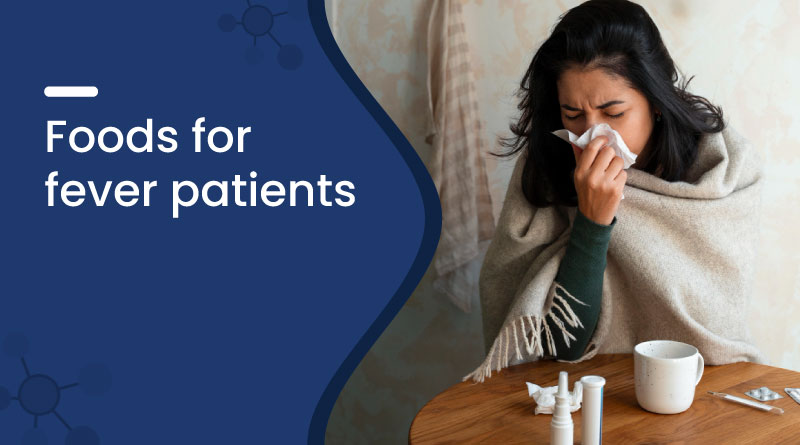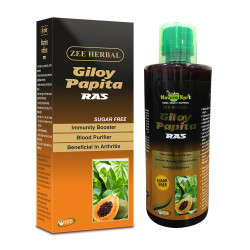Best Foods for Fever Patients | Easy-to-Digest & Immunity-Boosting


Fever is the body’s way of signaling that it’s battling an infection, often due to viruses or bacteria. The common symptoms of fever are chills, body aches, fatigue, and sweating. When you are suffering from a fever, the type of food you eat plays a major role in impacting the recovery period. In this blog, we will discuss the right foods for fever patients to ease symptoms, boost immunity, and support faster recovery.
Common Causes and Symptoms of Fever
Fever is not a disease; think of it as your body's first alert that the immune system is at work. An increase in body temperature above 100.4°F (38°C) helps the body combat infections. It can be triggered by various conditions like viral infections (flu or dengue), bacterial infections, inflammatory diseases, or even heat exhaustion. Symptoms may include:
- High body temperature
- Chills and sweating
- Headache or body ache
- Weakness and fatigue
- Dehydration or loss of appetite
Also read - Best Foods for Dengue Fever Patients
Role of Diet During Fever
When you have a fever, your body burns through nutrients faster. A fever may fade your appetite, but skipping meals will only delay recovery. Eating nourishing, easy-to-digest, fluid-rich foods packed with vitamins can help the immune system recover faster and prevent further weakness.
What To Eat During a Fever?
Easy-to-Digest Meals
- Khichdi: A comforting mix of rice and moong dal, rich in protein and easy on the stomach.
- Dalia (Broken wheat porridge): Great for energy and gut health.
- Upma: A gentle, filling option; it works well when you're not feeling very hungry.
Hydrating Soups & Broths
- Moong dal soup: A protein-rich Indian staple.
- Vegetable clear soup: Boosts vitamins and minerals.
- Chicken broth: Helpful in viral fevers, especially with cold and congestion.
Fresh Fruits & Steamed Veggies
- Bananas, papaya, apples: Gentle on digestion and help reduce inflammation.
- Steamed carrots, bottle gourd, spinach: These offer plenty of fiber and essential vitamins.
Protein-Rich but Light Foods
- Paneer (in moderation), boiled eggs, curd rice (if no chills): Gentle sources of protein and probiotics.
What Not to Eat in Fever?
Some foods can worsen inflammation or digestive issues. Stay away from:
- Fried and greasy foods that may upset the stomach and delay digestion.
- Spicy dishes that may aggravate symptoms like a sore throat or acidity.
- Sugary foods and cold desserts that can suppress the immune response.
- Caffeinated drinks that may dehydrate the body further.
- Raw salads or uncooked sprouts.
Indian Home Remedies for Fever
Home remedies have been passed down for generations in Indian households, offering relief from fever symptoms using everyday kitchen ingredients. These remedies don’t replace medical treatment but can complement it for faster recovery and relief.
- Tulsi Kadha (Holy Basil Decoction): Boil a few tulsi leaves with black pepper, ginger, and a pinch of cinnamon. Strain and sip warm. It boosts immunity and helps reduce body heat naturally.
- Turmeric Milk (Haldi Doodh): A warm glass of milk with a pinch of turmeric is a classic remedy to reduce inflammation, promote better sleep, and fight infection.
- Wet Cloth Therapy: Dip a clean cloth in cold water and place it on the forehead or feet. This helps in gradually bringing down body temperature without medication.
- Jeera Water: Cumin has antioxidant and anti-inflammatory properties. Boiling jeera in water and drinking it warm may help improve digestion and ease fever symptoms.
- Giloy Juice: Widely used in Ayurveda, giloy (guduchi) juice is known to reduce fever, purify the blood, and strengthen the immune system. Best taken in small quantities on an empty stomach.
Also read - Ayurvedic Medicine for Fever
Diet Tips for a Child with Fever
When kids run a fever, they are more vulnerable to dehydration and often lose their appetite, but their bodies still need nutrients to fight the infection.
- Suji kheer or dalia with milk
- Mashed khichdi or curd rice (if not cold)
- Fruit smoothies (room temperature)
- Homemade vegetable soup
Always monitor their temperature, and if symptoms persist, consult a pediatrician without delay.
Additional Tips for Faster Recovery
- Avoid alcohol and smoking.
- Maintain hygiene to prevent secondary infections.
- Try lukewarm sponge baths to lower the fever.
- Stick to a bland, soft diet even after the fever subsides for a day or two.
Conclusion
Recovering from a fever isn’t just about rest; it’s also about eating right. Choosing warm, nourishing, and easy-to-digest foods can ease symptoms, support immunity, and speed up recovery. Don’t ignore hydration, home remedies, and basic hygiene. Whether it’s khichdi, tulsi kadha, or curd rice, the right choices make a big difference. Always seek medical advice if the fever persists or worsens.
Also Read - Medicine for Fever
Frequently Asked Questions (FAQs)
Q. Can food really help in faster recovery from a fever?
A. Yes, eating nutrient-rich, easy-to-digest foods supports your immune system and speeds up healing.
Q. What are the best Indian foods to eat during a fever?
A. Khichdi, moong dal soup, dalia, curd rice, and steamed vegetables are ideal for fever recovery.
Q. Is drinking milk okay during a fever?
A. Yes, warm milk with turmeric can reduce inflammation and promote rest, but avoid it if you have a sore throat or cold.
Q. Can I give curd to my child if they have a fever?
A. If there’s no cold or sore throat, curd can be given in moderation for its probiotic benefits.
Q. How do I know when to visit a doctor for a fever?
A. If fever exceeds 102°F, lasts more than 3 days, or is accompanied by severe symptoms, seek medical attention.
Giloy (Tinospora Cordifolia) 300mg, Tulsi (Ocimum Sanctum) 200mg, Tulsi Oil (Ocimum Sanctum) 0.001 ml, Papita (Carica Papaya) 300mg, Ashwagandha (Withania Somnifera) 50mg, Aloe Vera (Aloe Barbadensis) 50mg, Punarnava (Boerhavia Diffusa) 50mg, Triphala 50mg
500 ml Bottle
Tinospora Cordifolia (Giloy Stem) (500mg)
100 capsules per jar
Recent Blogs
Disclaimer : Zeelab Pharmacy provides health information for knowledge only. Do not self-medicate. Always consult a qualified doctor before starting, stopping, or changing any medicine or treatment.


















 Added!
Added!